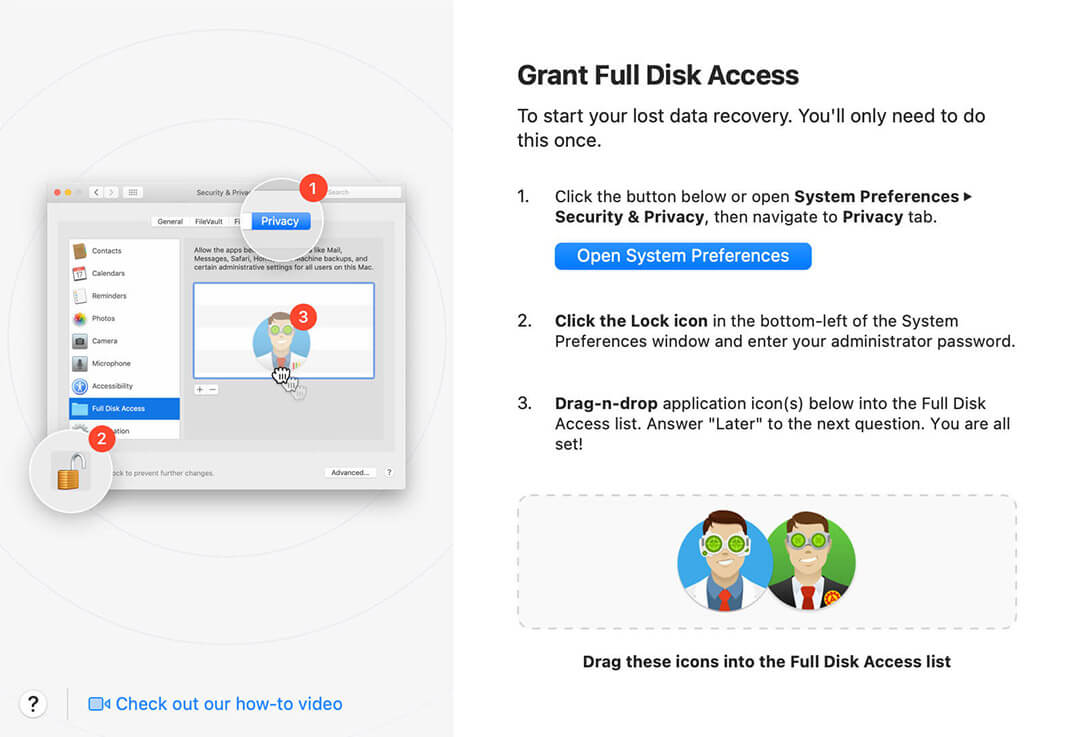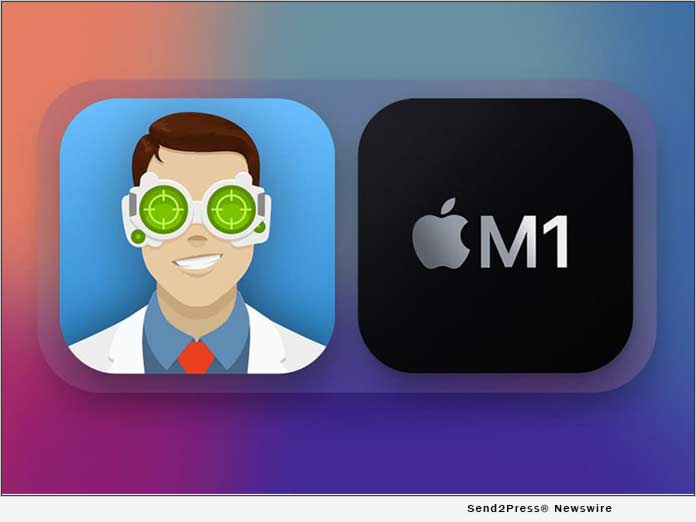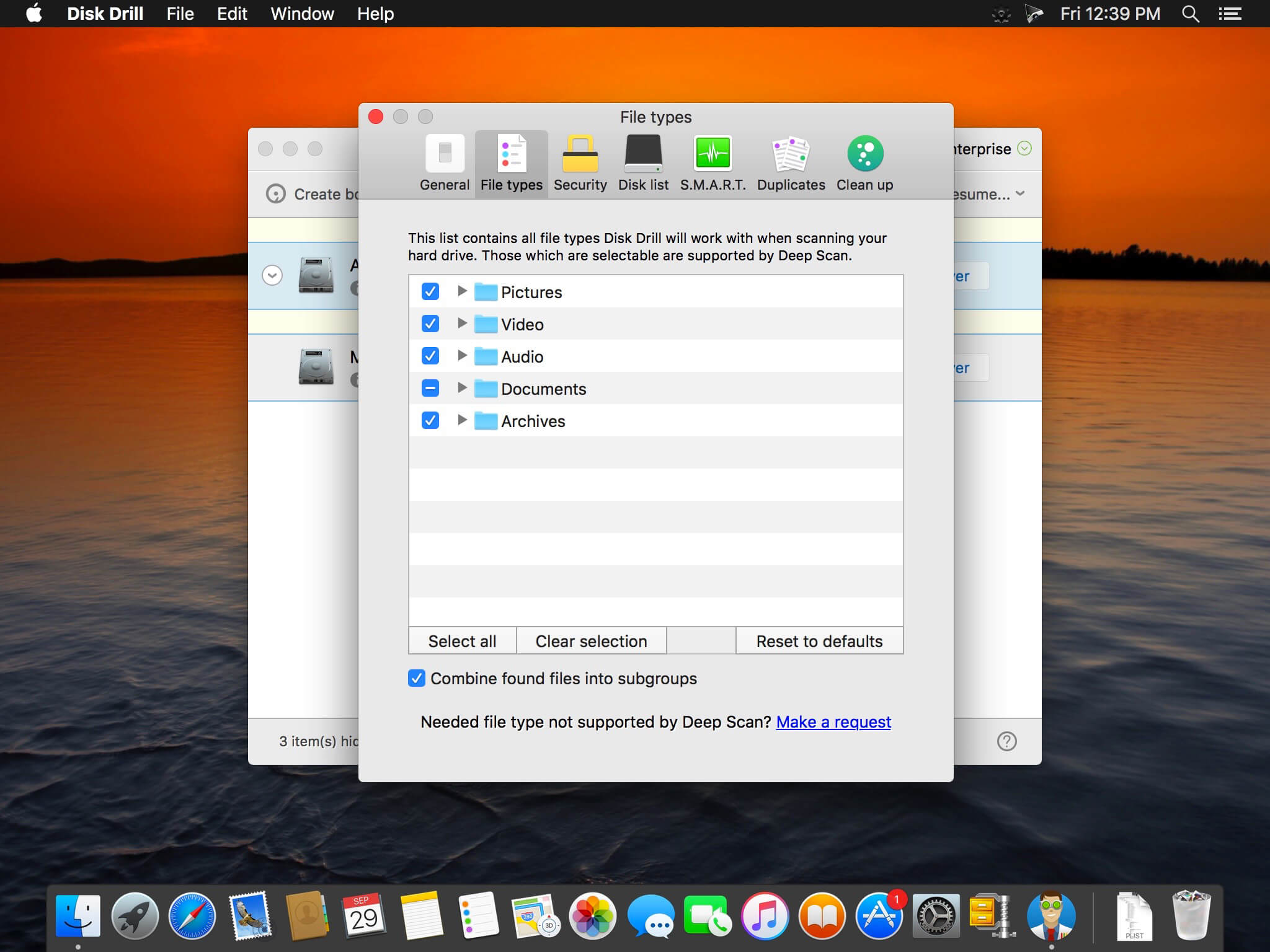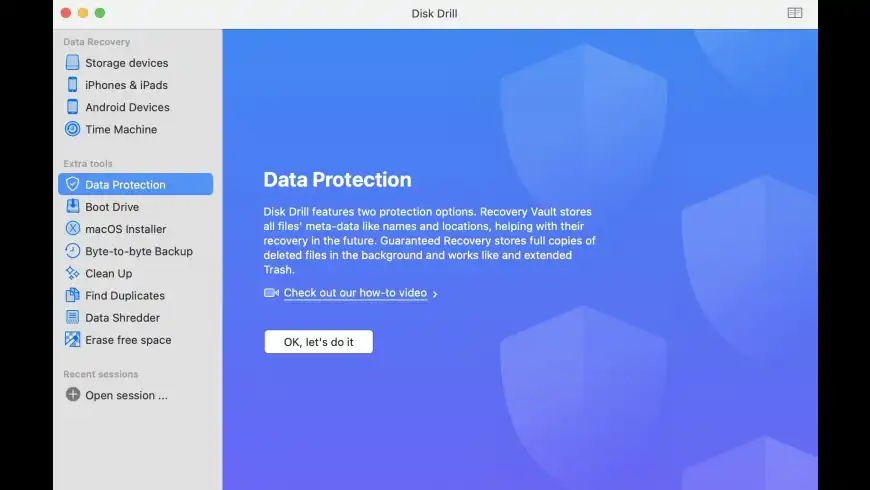Disk Drill 4.3 is the first data recovery app to run a native Deep Scan of system drives and the only available solution to recover deleted user folders on Macs powered by M1 chips
ALEXANDRIA, Va. /Massachusetts Newswire – National News/ — CleverFiles announces the release of their latest update of Disk Drill for Mac. Now the new Disk Drill 4.3 natively deep-scans system drives on Macs powered by Apple’s M1 chips without compromising on speed and efficiency of the recovery process.
Besides data recovery, Disk Drill also enables Mac users to analyze disk space and free up the hard drive with its Cleanup feature. Instead of regarding it as reliable data recovery software, it's more like a Mac disk management tool with data backup, disk cleanup, and duplicate files finder features.
To achieve the required level of decryption and access, Disk Drill deploys its own kernel extension, known as kext. With a number of system-level and administrator’s approvals, this enables Disk Drill to securely search for lost data in all user folders and system locations on the internal drives in macOS Big Sur on M1 Macs.
- Stellar Data Recovery for Mac. Simple and comprehensive data recovery software for Mac, Stellar.
- Disk Drill puts the emphasis on easy. You shouldn’t have to be a Macintosh expert to recover files. We have designed our app to ensure that you don’t have to spend hours figuring out a new software. And our online knowledge base provides detailed, step-by-step instructions for each Disk Drill feature.
“Our team has been developing system-level utilities for Macs since 2009. We’ve been improving Disk Drill for many years to ensure the maximum possible recovery rates, and we are extremely proud to be the first on the market to announce a full support of scanning and recovery from system partitions on Macs powered by Apple M1 chips,” says Serge S., the CEO at CleverFiles.
Disk Drill stands out in comparison to other data recovery apps for macOS, as it’s the first app to run a native Deep Scan of system drives on Macs powered by Apple’s M1 chips. Disk Drill is the only available solution to recover deleted user folders on M1 Macs, unlike other data recovery apps that can’t access and scan system locations.
Unlike other apps that run through a compatibility layer of Rosetta, Disk Drill is faster, more efficient, and fully compatible with the newest M1 chips. The same refers to SIP-protected external storage devices connected to M1 Macs – Disk Drill 4.3 is the only app out there that can scan and recover from them.
Recovering lost data from external drives is generally easier than scanning and restoring deleted files from internal or system drives on Macs. This is determined by the level of encryption macOS maintains to ensure its security protocols, including the M1 layer on the newest Mac devices. Disk Drill can find and undelete an accidental removal of user data on the main system drive, like the default Documents, Downloads, Applications and other familiar user folders.
About Disk Drill
Disk Drill can scan and recover over 400 various file types with a press of a single button, right from the computer’s internal or external drive, or any supported storage device. Files can be recovered in the original form, or reconstructed byte-by-byte in the event when the file system no longer contains their names or properties.
For fast, reliable file recovery Disk Drill comes with advanced scanning algorithms to identify and reconstruct deleted files in various formats, including the new raw photo, video and audio formats. Updated HFS+, APFS, exFAT, FAT32, and NTFS recovery algorithms, powered by Disk Drill’s smart scans, find more recoverable files, which allows for an improved (up to a 200%) recovery efficiency.
Disk Drill can successfully recover lost and deleted data from a computer’s internal disk as well as external drives, mobile devices, memory cards, digital cameras, and more. Accidentally deleted files can be easily retrieved with the Quick Scan.
For best recovery results, Disk Drill performs a Deep Scan, a thorough search on the entire drive to reconstruct lost files. In fact, the sequence of algorithms Disk Drill runs in the background is much more complicated than that, and is always adapted to a specific use case, ensuring the best recovery results for one’s file system, storage device condition, and other parameters.
Deep Scan is one of the most advanced Disk Drill’s recovery algorithms. It works even when hard drives lose their partitions and disk space is marked as unallocated. This Disk Drill release also concentrates on raw photos and videos, and substantially improves their recovery in many ways.
Pricing and Availability
Downloading the free version of Disk Drill 4.3 for Mac, customers can preview the data that can be recovered before upgrading to the Pro version for US $89 at https://www.cleverfiles.com/pro.html.
With a purchase of Disk Drill PRO for Mac, the customer also gets a license letting them use Disk Drill for Windows.
About CleverFiles
CleverFiles is a US-based software development company, specializing in data recovery solutions, creators of Disk Drill for Mac & Windows. Our mission is to secure personal data one computer at a time. Empowering users with affordable tools to solve everyday technical challenges. Clever Data Powers Clever Decisions. For more details please visit: https://www.cleverfiles.com/
VIDEO (YouTube): https://youtu.be/4o3aJjfRImQ
MEDIA CONTACT
Alina
alina@cleverfiles.com
404-512-2336
Learn More: https://www.cleverfiles.com/
This version of news story was published on and is Copr. © 2021 Massachusetts Newswire™ (MassachusettsNewswire.com) – part of the Neotrope® News Network, USA – all rights reserved.

Information is believed accurate but is not guaranteed. For questions about the above news, contact the company/org/person noted in the text and NOT this website.
Related News Stories:
Get a data lifeguard for Mac
Most of the time, when you connect an external hard drive to your Mac’s USB port, you soon see it mount on the desktop. Apple likes to ensure these are easy to find, so they also appear in the Finder in the left-hand column under Devices, since Mac’s treat them the same way as another computer.
However, sometimes, an external hard drive doesn't show up. It’s annoying, especially when you need to transfer something right then. And besides, there can be a risk that data on the external USB pen, hard, or flash drive is corrupt, which means you can’t transfer what you need between devices at all.
Corrupt data can be one reason your Mac won't recognize an external drive, but there are other reasons too. Let’s take a look at why this is happening and how you can get an external drive to appear on your Mac and get recover data to access your documents.
How to fix an external disk drive that won't show up on a Mac
Why an external disk drive is not showing up? There could be a few reasons why a USB flash drive isn’t making an appearance.
Access an External Drive Not Showing on Mac
Get a huge set of top utilities for troubleshooting external hard drives not mounting on a Mac
Start with the basics:
- Check whether the drive is properly plugged in. It sounds obvious, but since this relies on a wire - either a USB cable or HDMI cable - if it’s not connected properly then it won’t appear on your desktop.
- Faulty cable. Assuming it’s plugged in correctly, not wobbly or loose, the cable could be at fault. Try connecting the same device with a different cable.
- Damaged USB or flash drive port. It could be a hardware issue with the Mac. If you’ve got another port, try connecting the device to that one.
- Reboot your Mac. Sometimes, if a USB disk won't boot, the cause is a macOS issue. Hopefully, some data damage can be fixed by restarting. Choose the Apple menu > Restart. Or press and hold the power button and, when a dialog box appears, click the Restart or press R. Restarting your Mac essentially clears your macOS’s memory and starts it up fresh.
- Incorrectly formatted drive. Not every external drive is optimized for Macs. It could be that you are trying to connect something only fit to interact with Windows devices. If you’ve got a PC or laptop, it’s worth connecting and seeing if you can access the files through another device. The best way to look for an incorrectly formatted drive is to go to
Apple (in the top toolbar menu) > About This Mac > Storage.
See if the external drive shows up here. For more information, go to the same menu option, then select System Report. - Mac not formatted to display external drives on the desktop. It could be that your Mac already recognizes the device, but just isn’t showing its icon on the desktop screen. Even if that is the case, the drive will still appear in the left-hand column of the Finder menu under Devices. You should be able to access your drive that way, and, in the Finder menu under Preferences > General, you can check External Drives to ensure that from now on it shows up on your desktop too.
- Reset NVRAM. To do this, shut down or restart your Mac, switch it back on and immediately press these four keys together for at least 20 seconds: Option, Command, P, and R. It should look as though your Mac has started again; if it has, release the keys when you hear the second startup chime. Hopefully, the hard drive has shown up now.
- Check Apple’s Disk Utility to see if an external drive is showing up. Disk Utility is within System Preferences, or you can find it using Spotlight. If it is visible, then click the option to Mount, which should make it visible on the desktop and in the External Drives option in the Finder menu.
Unfortunately, if none of those options has worked and the external drive still isn’t visible, then it could have crashed, or be well and truly broken. But there might still be a way you can recover the data on the external drive.
How to show connected devices in Finder
- Go to the Finder menu and select Preferences (Cmd+comma).
- In General, click on External disks to ensure that from now on it shows on the desktop.
In the Sidebar tab you can choose which folders and devices will be shown in the left-hand column of the Finder window.
Disk Drill Catalina Download
How to add cloud storages to Finder

You can also mount cloud storage as a local drive on your Mac. By connecting Google Drive, Dropbox, or Amazon to your computer, you get more space for securely accessing and sharing files. For your ease, add cloud drives to Finder with CloudMounter so that you keep them close at hand. You can read detailed instructions on managing cloud storage as local drives here.
Repair the failed external drives with First Aid
The most direct reason your external hard drive could be detected by macOS, but can't be opened is the file system problem.
If your drive is having such problems, you can try to fix them yourself with First Aid and therefore get access to your files. First Aid tool will check the disk for errors and then attempt a repair as needed. It helps to verify and repair a range of issues related to startup HD and external drive problems. If you are able to fix the hard drive or SSD in your Mac (or an external drive) using Disk Utility you will hopefully be able to recover your files.

To run Fist Aid on an external hard drive:
- Open Disk Utility. You can search for it using Spotlight or via Finder > Go > Utilities
- Check on your external hard drive, click the First Aid tab and select Run to start running diagnostics.
If First Aid successful in fixing errors, the external drive should be available to mount. If the utility is unable to repair issues, your drive truly is broken or formatted using a file system that the Mac cannot read - in this way we suggest you follow the next steps to recover data from a damaged disk drive.
How to recover data from a crashed drive
Thankfully, there is an app for that. Disk Drill is the world’s premier data recovery software for Mac OS X. Powerful enough to retrieve long-lost, mistakenly deleted files from Macs, external hard drives, USB drives, and camera cards.
Get a file recovery app
With Setapp you get a pack of professional tools for file recovery and Mac maintenance.
An easy way to recover lost files on an external hard drive
Providing you already have Disk Drill Pro version, which you can get automatically by downloading from Setapp:
- Connect your drive to the Mac.
- Quit all other applications on the Mac, especially those that may be trying to access the external drive (e.g. iPhoto, Words)
- Launch Disk Drill.
- Click on the external drive that you are trying to recover files from. If it has partitions, you will see all of them. If, however, you still don’t see any volume to the external drive then you may need to try some of the steps above again or read the Disk Drill Scanning FAQs.
- To avoid the external drive being accessed during the recovery process, click Extras next to the drive or drive partition or file, then select Remount Volume As Read Only. A padlock will appear, protecting the drive during the process.
- Now click Rebuild (or Recover) next to the file(s) you are trying to recover. Once the scan is finished - it may take some time if the files are large - a list of files will appeal.
- Next, click Mount Found Items as Disk button on the bottom-left below the scan results.
- Disk Drill “strongly suggests saving the files to a different drive than the one you are trying to recover files from. Saving to the same drive substantially lowers your chances of recovery.”
- A drive icon will appear, which once you double click will give you the option to open the files as you would do before they were lost. Drag them to another location, such as your desktop or a folder on your Mac.
- Open the files to ensure they have been recovered properly and safely eject the external drive.
Disk Drill does have other ways to recover lost files but assuming there aren’t complications, this method is the most effective. Disk Drill Pro recovery app is available from Setapp, along with dozens of Mac apps that will make your life easier. Never have to worry about a crashed or corrupted external drive again.
A few more tips on getting your files back
- Macs and third-party apps that look after Macs, such as Disk Drill and iStat Menus come with a S.M.A.R.T. (also known as Self-Monitoring, Analysis, and Reporting Technology) status monitor. If a SMART check reports errors, then it could mean the hard drive is at risk of failing completely. Within Disk Utility and Disk Drill, there are several solutions for this: Repair Disk Permissions and Repair Disk. If neither of them works, it’s recommended to back up all of the data from the disk, erase it, then run a SMART check again. The external hard drive should show up as Verified.
- Partitions can get lost within hard drives, temporarily hiding all of the information contained within. Disk Drill can help to identify and restore this information.
- Within Disk Drill, you can restore data when a hard drive is damaged or add formatting, which is also something Disk Utility can help with.
- CleanMyMac, another useful app available from Setapp, can help you identify external hard drive errors and repair them. It is an essential tool worth trying when you’re having external hard drive difficulties.

Try all these apps for free
Get a huge set of top apps for keeping your Mac in shape. Best utilities in one pack, give it a go!
Alternative ways to recover data from an external hard drive
Reset the System Management Controller (SMC) if your Mac shuts down when you plug in an external hard drive. Then use a different port to connect the external hard drive. If you’ve got a battery that you can’t remove:
- Shut down and unplug the power adapter
- Press Shift-Control-Option and the power button at the same time. Do this for 10 seconds
- Release all keys
- Plug the power adapter back in and switch your Mac back on
For Macs with removable batteries, you need to switch them off, remove the battery, then press and hold the power button for 5 seconds. After that, put the battery back in, plug in the power adapter and switch the power on again.
What’s your file format? One reason your Mac isn’t recognizing the hard drive is the file format. Windows uses NTFS file formats, while Macs, up until the introduction of Sierra, have used HFS+. Now, Apple has introduced the Apple File System (APFS) for newer operating systems. It is possible to format a hard drive so it can be read on Mac and Windows computers, providing you format using exFAT. However, if you’re having problems accessing the files and the issue is due to formatting, you will need to connect it to a device it can be read on, and then format the files correctly for the computer you are going to use next.
How to make Ext2/Ext3 drives readable on Mac
The common issue is Ext2- and Ext3-formatted drives are not readable on macOS. There are two ways to access such external drives on your Mac – via Linux OS or FUSE system. The easiest would be installing Linux to a secondary drive or virtual machine.
If you go with Linux installation, dual boot your Mac with Linux on another drive and use FAT32 as a transfer intermediary. If you don’t have a drive to install Linux to, use a virtual machine as an interface for it. Transferring can be done the same way – with FAT32, or via network.
What Is Disk Drill For Mac
Another option for reading Ext2/Ext3 disks is mounting disk with Filesystem in Userspace (FUSE). Basically, it works as an extra interface enabling file system access via specially installed modules. Here’s how to mount drives with FUSE:
- Install FUSE for macOS or MacFUSE as well as a fuse-ext2 module.
- Use the following Terminal command to enable Disk Utility’s debug menu and see all partitions: defaults write com.apple.DiskUtility DUDebugMenuEnabled 1
- Attach your Ext2/Ext3 drive and locate the device name via Disk Utility.
- In your user account, create a folder to be used as a mount point.
- Use the following Terminal command to mount the drive as read-only: fuse-ext2 /dev/disk2s2 /Volumes/mountpoint
- For write support, use the command: fuse-ext2 -o force /dev/disk2s2 /Volumes/mountpoint
Disk Drill Catalina Mac
And that’s not the only case where Terminal helps you access external drive.
Employ the handy all-powerful Terminal, which always comes forward with solutions for difficult problems. Especially if System Information does recognize the USB or hard drive, but continues to hide it from you, disconnect the drive and try to find it using the Terminal, which you can find in Applications > Utilities.

- Once in the Terminal, type in the command diskutil list
- A list with information about volumes and drives should appear
- Look for a section labelled /dev/disk_ (external, physical)
- Make a note of the whole line after the word disk
- Now put the following command into the Terminal diskutil info disk followed by the number or digits assigned to that disk
- Now you should see detailed information about the drive, therefore confirming that your Mac can and does recognize it
- Eject using the Terminal by entering the command diskutil eject disk followed by the number or digits assigned to that disk
- Physically remove the disk from your Mac
- Plug it back in and your Mac should recognize it
Console is also reliable when it comes to solving tricky problems, although it isn’t always that easy to use. You can find Console under Applications > Utilities > Console. Console shows if an external drive or any error is detected under the Errors and Faults tab. If no errors show up, then the problem is not caused by the device.
To sum up, there are lots of potential solutions for a Mac not reading an external hard drive. If we were to pick one, Disk Drill seems to be the most well-rounded, offering plenty of customizations and power in an easy-to-use interface. Disk Drill Pro recovery app is available via Setapp, along with 200+ Mac apps that strive to make your life much much easier. At the very least, you’ll never have to worry about a crashed or corrupted external drive ever again.
Meantime, prepare for all the awesome things you can do with Setapp.
Read onSign Up
